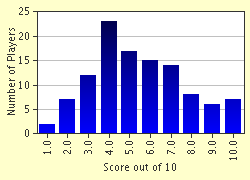Quiz Answer Key and Fun Facts
1. Perhaps the most compelling evidence for Pete Browning's inclusion in the Hall of Fame is his lifetime batting average of .341, the highest of any eligible player not enshrined. Which of these Hall of Famers had a higher lifetime batting average than Pete Browning?
2. In addition to being one of the elite percentage hitters of all time, Browning is also famous for lending one of his many nicknames to the single most popular line of baseball bat ever marketed, original designs of which were made to his exacting, if eccentric, specifications. What moniker did longtime Louisville star Pete Browning bequeath to this perrenial presence on ballfields everywhere?
3. Browning led the league in batting average three times in his career. More impressive than this mark, however, is the number of near-misses he had. How many times did Pete Browning finish in the top three in league batting average?
4. One of the favorite "new" statistics amongst baseball scholars to measure a hitter's production is OPS+. This intricate gauge is figured by adding a player's slugging percentage and on-base percentage together, dividing this figure by the league average during the player's career, and multiplying by 100. Thus, a player who produces at league average has an OPS+ of 100, a player who produces twice the average has an OPS+ of 200, and so forth. To give some idea of scale, Babe Ruth's OPS+ is 207. What is Pete Browning's OPS+?
5. Pete Browning's career ran from 1882-1894, a period of rapid change in professional baseball. In which league did Browning play the bulk of his games?
6. In 1890, National League star and professional attorney John Montgomery Ward led a "Brotherhood" movement that founded a breakaway "Players League" owned by the athletes themselves. Many established big-league stars, including the famed Michael "King" Kelly and Big Dan Brouthers, joined this revolutionary movement, while other stalwarts, such as Cap Anson and "Sliding" Billy Hamilton, remained on the owners' side. What was Pete Browning's role in the "Players League War"?
7. As a hitter, Browning was clearly among the elite of his time, perhaps the very best. Which of these accurately describes his fielding performance?
8. Official Hall of Fame rules dictate that selection "shall be based upon the player's record, playing ability, integrity, sportsmanship, character, and contributions to the team(s) on which the player played." Well, Browning was certainly a character! Almost a caricature of the lovable drunk, his nickname "The Gladiator" was inspired both by his competitive nature and his constant wars with the bottle.
9. Though his colorful lifestyle often overshadowed it, Browning did show great courage in overcoming a substantial disability to have the career that he did. What was this physical limitation?
10. Baseball Hall of Fame policies encourage fans to lobby members of the Veterans' Committee for the induction of worthy candidates, and you can do so for Pete Browning if this quiz has convinced you that he is worthy of the honor.
Source: Author
stuthehistoryguy
This quiz was reviewed by FunTrivia editor
Nightmare before going online.
Any errors found in FunTrivia content are routinely corrected through our feedback system.

